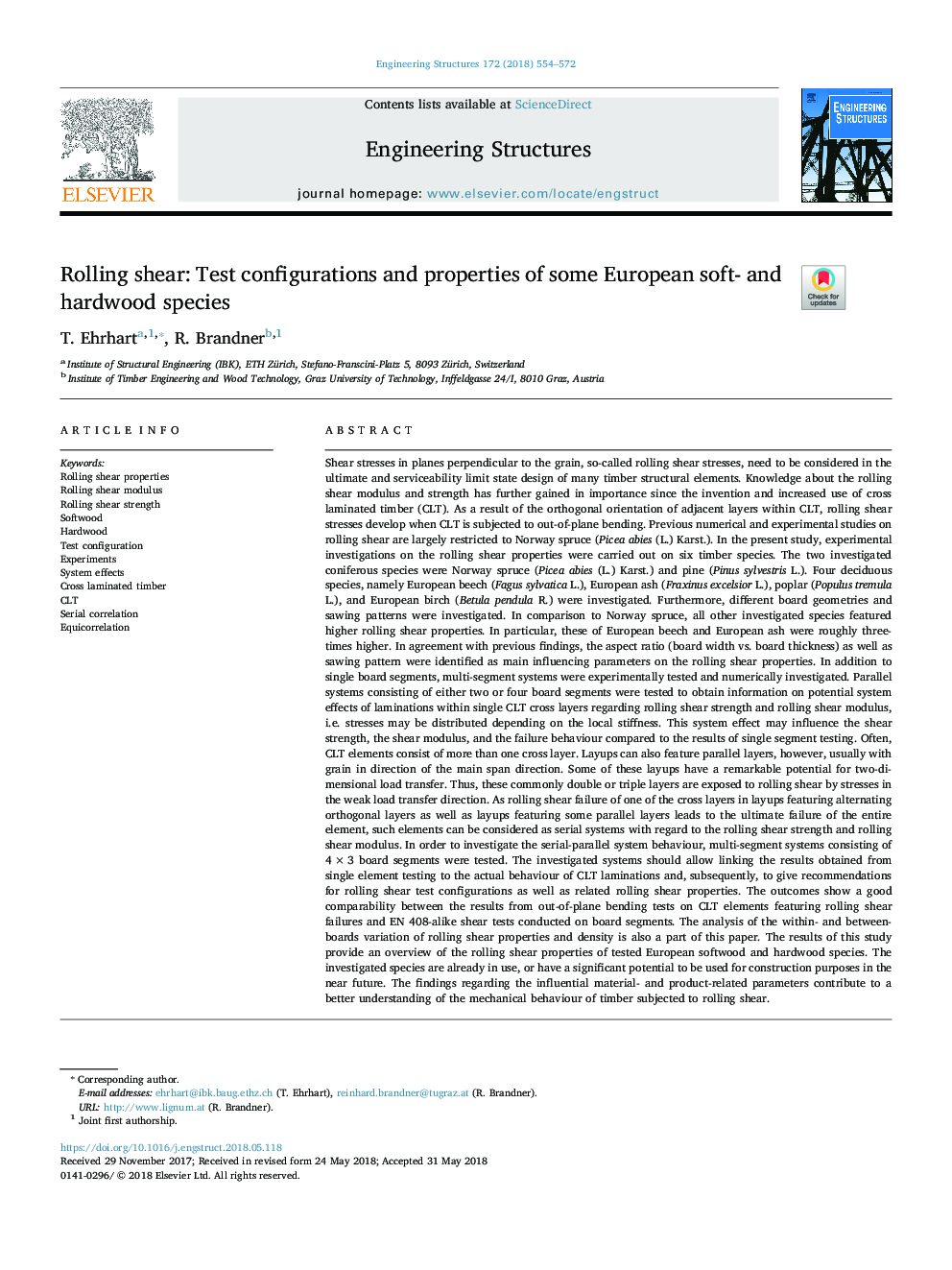| کد مقاله | کد نشریه | سال انتشار | مقاله انگلیسی | نسخه تمام متن |
|---|---|---|---|---|
| 6736193 | 1429055 | 2018 | 19 صفحه PDF | دانلود رایگان |
عنوان انگلیسی مقاله ISI
Rolling shear: Test configurations and properties of some European soft- and hardwood species
ترجمه فارسی عنوان
برش نورد: تست تنظیمات و خواص برخی از گونه های نرم و سخت چوب اروپایی
دانلود مقاله + سفارش ترجمه
دانلود مقاله ISI انگلیسی
رایگان برای ایرانیان
کلمات کلیدی
موضوعات مرتبط
مهندسی و علوم پایه
علوم زمین و سیارات
مهندسی ژئوتکنیک و زمین شناسی مهندسی
چکیده انگلیسی
Shear stresses in planes perpendicular to the grain, so-called rolling shear stresses, need to be considered in the ultimate and serviceability limit state design of many timber structural elements. Knowledge about the rolling shear modulus and strength has further gained in importance since the invention and increased use of cross laminated timber (CLT). As a result of the orthogonal orientation of adjacent layers within CLT, rolling shear stresses develop when CLT is subjected to out-of-plane bending. Previous numerical and experimental studies on rolling shear are largely restricted to Norway spruce (Picea abies (L.) Karst.). In the present study, experimental investigations on the rolling shear properties were carried out on six timber species. The two investigated coniferous species were Norway spruce (Picea abies (L.) Karst.) and pine (Pinus sylvestris L.). Four deciduous species, namely European beech (Fagus sylvatica L.), European ash (Fraxinus excelsior L.), poplar (Populus tremula L.), and European birch (Betula pendula R.) were investigated. Furthermore, different board geometries and sawing patterns were investigated. In comparison to Norway spruce, all other investigated species featured higher rolling shear properties. In particular, these of European beech and European ash were roughly three-times higher. In agreement with previous findings, the aspect ratio (board width vs. board thickness) as well as sawing pattern were identified as main influencing parameters on the rolling shear properties. In addition to single board segments, multi-segment systems were experimentally tested and numerically investigated. Parallel systems consisting of either two or four board segments were tested to obtain information on potential system effects of laminations within single CLT cross layers regarding rolling shear strength and rolling shear modulus, i.e. stresses may be distributed depending on the local stiffness. This system effect may influence the shear strength, the shear modulus, and the failure behaviour compared to the results of single segment testing. Often, CLT elements consist of more than one cross layer. Layups can also feature parallel layers, however, usually with grain in direction of the main span direction. Some of these layups have a remarkable potential for two-dimensional load transfer. Thus, these commonly double or triple layers are exposed to rolling shear by stresses in the weak load transfer direction. As rolling shear failure of one of the cross layers in layups featuring alternating orthogonal layers as well as layups featuring some parallel layers leads to the ultimate failure of the entire element, such elements can be considered as serial systems with regard to the rolling shear strength and rolling shear modulus. In order to investigate the serial-parallel system behaviour, multi-segment systems consisting of 4â¯Ãâ¯3 board segments were tested. The investigated systems should allow linking the results obtained from single element testing to the actual behaviour of CLT laminations and, subsequently, to give recommendations for rolling shear test configurations as well as related rolling shear properties. The outcomes show a good comparability between the results from out-of-plane bending tests on CLT elements featuring rolling shear failures and EN 408-alike shear tests conducted on board segments. The analysis of the within- and between-boards variation of rolling shear properties and density is also a part of this paper. The results of this study provide an overview of the rolling shear properties of tested European softwood and hardwood species. The investigated species are already in use, or have a significant potential to be used for construction purposes in the near future. The findings regarding the influential material- and product-related parameters contribute to a better understanding of the mechanical behaviour of timber subjected to rolling shear.
ناشر
Database: Elsevier - ScienceDirect (ساینس دایرکت)
Journal: Engineering Structures - Volume 172, 1 October 2018, Pages 554-572
Journal: Engineering Structures - Volume 172, 1 October 2018, Pages 554-572
نویسندگان
T. Ehrhart, R. Brandner,
